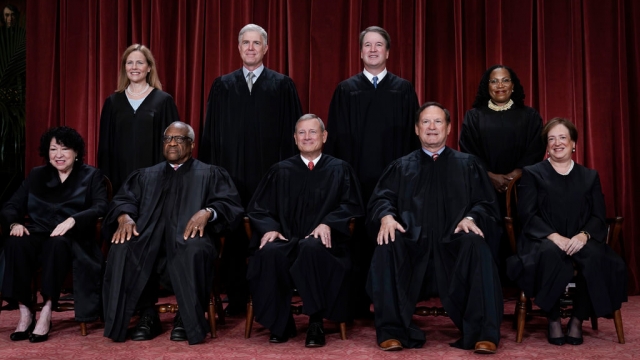The Supreme Court is the highest court in the land, and its rulings have shaped the United States for over two centuries. But some recent decisions have put a spotlight on the high court.
In April, the Supreme Court issued an order to keep a widely used abortion pill on the market. In early June, the court ruled that Alabama violated theVoting Rights Act through gerrymandering. And at the end of the session this week, the court ruled against affirmative action policies at universities and struck down the Biden administration's student loan forgiveness plan.
The high-profile decisions come as polling finds public approval at an all-time low.
Only 25% of Americans have confidence in the Supreme Court, according to Gallup. That's a dive of more than 10% compared to the same time last year. Ethics scandals have rocked the court over the past year, including a long list of conflicts of interest, from a lack of recusals to undeclared payments and gifts.
Precedent has played a crucial role on the bench since it first took shape in the late 18th century.
The court was first assembled during President George Washington's time in office. The Judicial Act of 1789 established an early version of the three-tiered federal court system of district courts, circuit courts, and the Supreme Court.
The court's more than 230-year legacy largely remains in its original form, despite a few amendments. The president nominates justices, but Congress decides how many justices are on the bench.
SEE MORE: Latest Supreme Court decisions specifically affecting Black Americans
That number changed a total of six times before lawmakers settled on the current nine-justice makeup in 1869.
Some polling also indicates Americans are mixed or growing more favorable to expanding the court.
The constitution says, "To ensure an independent judiciary and to protect judges from partisan pressures, the constitution provides that judges serve during "good behavior," which generally means until justices retire or die. However, the constitution does not specify qualifications for justices.
The Supreme Court says they can be any age, have any education, or have any profession.
A justice doesn't even have to be a lawyer or a law school graduate. But historically, all have been trained in the law. Unlike other court figures, the U.S. Supreme Court is the only judicial body in the country that does not have to follow an ethics code. But they aren't really allowed to act unethically. If they do, that could result in impeachment.
There is a statute that requires justices to recuse themselves from a case if there's a conflict of interest.
Article 3 of the U.S. Constitution gives the U.S. Supreme Court jurisdiction over all U.S. laws, especially in cases that involve a law's constitutionality. It has the power to decide appeals on all cases brought in federal court or in state court if they deal with federal law.
SEE MORE: The Supreme Court will return to gun laws when it starts its next term
The court's term begins in October, and the justices hear oral arguments for the next seven months.
In those hearings, lawyers for each side lay out their legal case. The court will typically discuss the cases with their law clerks to identify different views and form an idea of how they'll vote. The justices then hold private conferences to decide the case. Supreme Court protocol says all justices have the opportunity to share their views without interruptions.
The justices speak in order of seniority, starting with current Chief Justice John Roberts. Once the votes are in, the most senior justice in the majority and minority decides who will write the court's opinion.
Those opinions don't become final until the ruling is made available to the public.
Justices have long held true to confidentiality and are not subject to the federal Freedom of Information Act; oral arguments have never been televised. And it wasn't until 2020 that the court began offering live audio from inside the courtroom.
But despite any controversy surrounding a case, the court pledges to uphold its ultimate responsibility. The one written above the court's
main entrance in Washington: "Equal justice under law."
Trending stories at Scrippsnews.com



